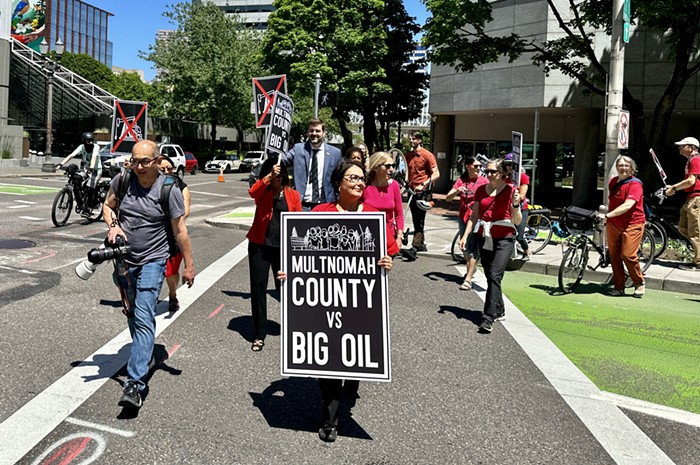Across Germany, France, and Italy, it resides on the Eurail tracks and the tops of buildings. But the graffiti in Barcelona, Spain is particularly beautiful. The city towers with famously elaborate architecture--wrought-iron castles and Gaudi cathedrals puncture the sky. Beneath its endless vistas, giant, colorful murals--influenced by Miro, Dali, Picasso--populate the walls of narrow streets.
Near the contemporary art museum, where temporary walls have been erected to protect a construction site, panels of graffiti go up on a regular basis--sometimes lasting only a night before another artist claims the space for his or her own. The variety of styles is astonishing: there's a Peter Max-style portrait, a bubbly, pop-art girl riding a ski-lift, a pattern of crazed chickens declaring that it's the "Ano del pollo. " One abstract panel, thick with oil paint, is marked en proceso; next to it, a painting of a man declares "Ice Ice Beibe!!" I was thinking it depicted a young Fidel Castro--until one of the local skateboarders corrected me. It's a self-portrait of the artist.
In Barcelona, a differentiation is made between graffiti and vandalism, the latter defined as non-artistic spray paint on homes, trees, beautiful buildings, etc. Unfortunately, as anyone who's seen Style Wars can attest, things are different here in America. According to bcngraffiti.com, "A vociferous anti-vandal lobby in the USA has failed to recognize the differences between graffiti & vandalism. Its highly vocal campaigners have used public resources & funding to criminalize graffiti communities in many states throughout the US."
When my friend and I visited Barcelona this summer, we were lucky enough to stumble upon a poster advertising "Graffiti al Parc"--a five-hour event sponsored by the city of Barcelona, in which local graffiti artists were commissioned to paint murals on new walls in a public space. The Ajuntament [Town Council] de Barcelona also paid for lunch, as well as a DJ with a banging sound system so the artists could listen to music while they painted. The description on the council's website reads in Catalan:
"Graffiti al Parc" es una iniciativa que es celebrará durant la Festa Major del Poble-sec d'enguany. Un nombrós grup d'artistes urbans de la ciutat, pintarán durant més de 5 hores sis grans murals en una demostració que no tot es vandalisme en el món del graffiti.
We stayed in le Parc de les Tres Xemeneies for the duration of the event, watching about 30 men and women paint elaborate pieces. It was the first time we'd seen anyone paint graffiti in broad daylight (without masks to conceal their identities) and consequently, the experience resulted in some of the best graf art we'd ever seen. The fact that the city sponsored such an event conveyed the message it was proud of its culture and artists; even graffiti artists whose paintings take up public space.
To them, graf artists are doing the public a service--giving the city art for free. And many of the tags that butted the mural art were political, representative of the Catalonian secessionist movement: "Catalunya Independent," they said, or "Morta España." And even in English, such as "British and American tourists: the war in Iraq makes you a target." This juxtaposition represents the idea of graffiti as vox populi--artists and activists, side by side, expressing their entitlement to the space in which they live.
THINGS IN PORTLAND ARE DIFFERENT
In Portland, the legal consequences of writing graffiti are based on the cost of damage, but can incur heavy fines and, more rarely, prison time. Thanks to city code, those wishing to commission a mural on their own property must leap through bureaucratic hoops; a clear message the city looks at public art as a nuisance. Naturally this only pertains to certain types; last year, the Regional Arts and Culture Council spent $850,588 on public art.
What if Portland designated spaces for graffiti and commissioned graffiti artists to make outdoor art? Currently, Portland doesn't have a single wall that can legally be used as a canvas for the public. In a city that supposedly prides itself in supporting a flourishing artisanship, certain artists are being ignored and criminalized.
Though it may be surprising to some, according to Portland's Graffiti Removal Program, less than one percent of graffiti in Portland is gang-related. Their viewpoint of graffiti is rooted in what former NYC Mayor Rudy Guiliani called the "broken window syndrome"--the idea that graffiti is a sign of urban decay and a "gateway crime" to worse infractions, ultimately degrading community livability.
But what if we rethink what graffiti means to our city? What if we take more pride in our artists, validate their voices, give them a place to paint? If we look at their work as a form of urban renewal, and their art as integral to the city's culture, this acceptance would undoubtedly raise the quality of the artwork.
In Barcelona, the art is diverse and beautiful, adding incredible color and depth to the urban landscape. I keep thinking back to the explanation the Ajutament gave for supporting the Graffiti al Parc; essentially, the city paid the artists for five hours of painting, in an effort to support a new urban vision: graffiti is not always vandalism.
Portland is a city of grays--but with the proper support of its artists, could be as colorful as Barcelona.












